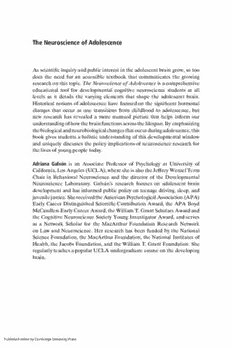
The Neuroscience of Adolescence PDF
Preview The Neuroscience of Adolescence
The Neuroscience of Adolescence Asscientificinquiryandpublicinterestintheadolescentbraingrow,sotoo does the need for an accessible textbook that communicates the growing researchonthistopic.TheNeuroscienceofAdolescenceisacomprehensive educational tool for developmental cognitive neuroscience students at all levels as it details the varying elements that shape the adolescent brain. Historicalnotionsofadolescencehavefocusedonthesignificanthormonal changes that occur as one transitions from childhood to adolescence, but new research has revealed a more nuanced picture that helps inform our understandingofhowthebrainfunctionsacrossthelifespan.Byemphasizing thebiologicalandneurobiologicalchangesthatoccurduringadolescence,this bookgivesstudentsaholisticunderstandingofthisdevelopmentalwindow anduniquelydiscussesthepolicyimplicationsofneuroscienceresearchfor thelivesofyoungpeopletoday. Adriana Galva´n is an Associate Professor of Psychology at University of California,LosAngeles(UCLA),wheresheisalsotheJeffreyWenzelTerm Chair in Behavioral Neuroscience and the director of the Developmental Neuroscience Laboratory. Galva´n’s research focuses on adolescent brain developmentandhasinformedpublicpolicyonteenagedriving,sleep,and juvenilejustice.ShereceivedtheAmericanPsychologicalAssociation(APA) Early Career Distinguished Scientific Contribution Award, the APA Boyd McCandlessEarlyCareerAward,theWilliamT.GrantScholarsAwardand theCognitiveNeuroscienceSocietyYoungInvestigatorAward,andserves as a Network Scholar for the MacArthur Foundation Research Network on Law and Neuroscience. Her research has been funded by the National ScienceFoundation,theMacArthurFoundation,theNationalInstitutesof Health,theJacobsFoundation,andtheWilliamT.GrantFoundation.She regularlyteachesapopularUCLAundergraduatecourseonthedeveloping brain. Published online by Cambridge University Press CambridgeFundamentalsofNeuroscienceinPsychology Developedinresponsetoagrowingneedtomakeneuroscienceaccessible tostudentsandothernon-specialistreaders,theCambridgeFundamentalsof NeuroscienceinPsychologyseriesprovidesbriefintroductionstokeyareas of neuroscience research across major domains of psychology. Written by experts in cognitive, social, affective, developmental, clinical, and applied neuroscience,thesebookswillserveasidealprimersforstudentsandother readersseekinganentrypointtothechallengingworldofneuroscience. ForthcomingTitlesintheSeries: TheNeuroscienceofIntelligence,byRichardJ.Haier TheNeuroscienceofExpertise,byMerimBilalic´ CognitiveNeuroscienceofMemory,byScottD.Slotnick TheNeuroscienceofAging,byAngelaGutchess TheNeuroscienceofAddiction,byFrancescaFilbey Published online by Cambridge University Press The Neuroscience of Adolescence Adriana Galva´n UniversityofCalifornia,LosAngeles Published online by Cambridge University Press UniversityPrintingHouse,CambridgeCB28BS,UnitedKingdom OneLibertyPlaza,20thFloor,NewYork,NY10006,USA 477WilliamstownRoad,PortMelbourne,VIC3207,Australia 4843/24,2ndFloor,AnsariRoad,Daryaganj,Delhi–110002,India 79AnsonRoad,#06–04/06,Singapore079906 CambridgeUniversityPressispartoftheUniversityofCambridge. ItfurtherstheUniversity’smissionbydisseminatingknowledgeinthepursuitof education,learning,andresearchatthehighestinternationallevelsofexcellence. www.cambridge.org Informationonthistitle:www.cambridge.org/9781107089921 DOI:10.1017/9781316106143 (cid:2)C AdrianaGalva´n2017 Thispublicationisincopyright.Subjecttostatutoryexception andtotheprovisionsofrelevantcollectivelicensingagreements, noreproductionofanypartmaytakeplacewithoutthewritten permissionofCambridgeUniversityPress. Firstpublished2017 PrintedintheUnitedStatesofAmericabySheridanBooks,Inc.in2017 AcataloguerecordforthispublicationisavailablefromtheBritishLibrary. LibraryofCongressCataloginginPublicationData Names:Galvaa´n,Adriana,1979–author. Title:Theneuroscienceofadolescence/AdrianaGalva´n. Description:Cambridge,UnitedKingdom;NewYork,NY:CambridgeUniversity Press,2017|Includesbibliographicalreferences. Identifiers:LCCN2016048271|ISBN9781107089921(hardback)| ISBN9781107461857(paperback) Subjects:|MESH:MentalProcesses–physiology|Adolescent–physiology| Brain–physiology|Puberty–physiology|AdolescentDevelopment–physiology Classification:LCCRJ503.7.A36|NLMWL337|DDC616.800835–dc23 LCrecordavailableathttps://lccn.loc.gov/2016048271 ISBN978-1-107-08992-1Hardback ISBN978-1-107-46185-7Paperback CambridgeUniversityPresshasnoresponsibilityforthepersistenceoraccuracy ofURLsforexternalorthird-partyInternetWebsitesreferredtointhispublication, anddoesnotguaranteethatanycontentonsuchWebsitesis,orwillremain, accurateorappropriate. Published online by Cambridge University Press TothepastandcurrentstudentsofPsych161atUCLA Tomyparentsandsisters,t.k.m. Tomyfutureadolescents,GustavoandLucia TomyinspiringhusbandBill Published online by Cambridge University Press Published online by Cambridge University Press Contents ListofFigures pagexii Preface xvii 1 WhatIsAdolescence? 1 1.1 Introduction 1 1.2 PeriodsofDevelopment 2 1.2.1 Childhood 2 1.2.2 Adolescence 3 1.2.3 Adulthood 3 1.3 Adolescence:AHistoricalPerspective 5 1.4 AdolescenceacrosstheGlobeandacrossSpecies 6 1.5 TheoreticalModelsofAdolescentBrainDevelopment 7 1.5.1 DualSystemsModel 7 1.5.2 TriadicModel 9 1.5.3 ImbalanceModel 9 1.5.4 SocialInformationProcessingModel 10 1.5.5 FuzzyTraceTheory 10 1.6 WhatistheFunctionofAdolescence? 11 1.6.1 HowDoestheBrainFacilitateIndependence? 15 1.7 HumanBrainDevelopment:AnOverview 15 1.7.1 InteractiveSpecializationFramework 16 1.8 TheImportanceofUnderstandingAdolescentBrain Development 17 1.9 TheImportanceofAnimalModels 18 1.10 ChapterSummary 19 1.11 ReviewQuestions 20 2 Puberty 21 2.1 Introduction 21 2.2 PubertalHormones 22 2.3 NeuroendocrineSystem 23 2.3.1 AdrenarcheandGonadarche 25 2.4 WhatTriggersPuberty? 26 2.5 TimingIsEverything 29 2.5.1 GeneticFactors 30 2.5.2 PsychosocialFactors 30 Published online by Cambridge University Press viii Contents 2.5.3 EthnicDifferences 31 2.5.4 EarlyandLateMaturation 33 2.6 PubertalImplicationsonBehavior 36 2.6.1 PubertalTimingEffectsonPsychopathology 36 2.7 “You’veGottensoTall!” 38 2.8 BoneAge 39 2.9 PubertyandBrainStructure 40 2.9.1 GrayMatter 41 2.9.2 WhiteMatter 45 2.10 PubertyandBrainFunction 45 2.11 ChapterSummary 48 2.12 ReviewQuestions 48 3 CognitiveNeuroscienceMethodstoStudytheAdolescentBrain 50 3.1 Introduction 50 3.2 BrainScans 51 3.2.1 StructuralMagneticResonanceImaging (sMRI) 51 3.2.2 DiffusionTensorImaging(DTI) 56 3.2.3 FunctionalMagneticResonanceImaging (fMRI) 58 3.2.4 FunctionalConnectivity 60 3.3 Electrophysiology 67 3.3.1 Electroencephalography(EEG) 67 3.3.2 Magnetoencephalography(MEG) 67 3.3.3 StrengthsandLimitations 69 3.4 Eye-Tracking 71 3.4.1 StrengthsandLimitations 73 3.5 RecruitingAdolescentResearchVolunteers 73 3.6 ComputerizedTasks 74 3.7 AnalyticalConsiderations 76 3.7.1 PerformanceDifferences 76 3.7.2 The“TaskB”Problem 78 3.7.3 PhysiologicalDifferences 80 3.7.4 InterpretingGroupDifferences 81 3.8 ChapterSummary 83 3.9 ReviewQuestions 84 4 BrainPlasticity 85 4.1 Introduction 85 4.2 Neuroplasticity,Defined 86 Published online by Cambridge University Press Contents ix 4.3 NeuralMechanismsofPlasticity 86 4.3.1 NeuroplasticityMechanisms 87 4.4 CriticalPeriods 92 4.4.1 Experience-ExpectantMechanisms 93 4.4.2 Experience-DependentProcesses 96 4.5 NeuroimagingEvidenceofPlasticityinHumans 98 4.5.1 ResearchinAdults 98 4.5.2 ResearchinChildren 101 4.5.3 ThePlasticityofDevelopmentalTiming 102 4.6 WhyIsPlasticityAdaptive? 104 4.6.1 OpportunitiesforInterventionandRemediation 105 4.6.2 Cross-ModalPlasticity 106 4.6.3 Psychotherapy 107 4.6.4 Exercise 108 4.7 AdverseEnvironmentsandPlasticity 109 4.7.1 SocioeconomicStatusandPlasticity 111 4.8 ChapterSummary 114 4.9 ReviewQuestions 114 5 NeurocognitiveDevelopment 116 5.1 Introduction 116 5.2 Cognition,Defined 117 5.3 PrefrontalCortex–anEvolutionaryHistory 117 5.3.1 WhyDoWeNeedaPrefrontalCortex? 121 5.4 TheA-not-BTask 123 5.4.1 TheRoleoftheDorsolateralPrefrontalCortexin A-not-B 125 5.5 StructuralDevelopmentofthePrefrontalCortex 125 5.5.1 GrayMatter 128 5.5.2 WhiteMatter 129 5.5.3 SexDifferences 129 5.5.4 StructuralDevelopmentalinClinicalPopulations 130 5.5.5 EffectsofPsychopharmacologicalTreatmenton Neurodevelopment 134 5.6 FunctionalDevelopmentofthePrefrontalCortex 135 5.6.1 CognitiveControl 136 5.7 FunctionalConnectivity 144 5.8 WorkingMemory 146 5.9 Implications 148 5.10 ChapterSummary 150 5.11 ReviewQuestions 150 Published online by Cambridge University Press x Contents 6 MotivationalSystems 151 6.1 Introduction 151 6.2 WhatIsaReward? 151 6.3 TheRewardSystem 152 6.3.1 TheDevelopmentoftheDopamineSystem 153 6.3.2 RewardNeurocircuitry 155 6.3.3 MRIStudiesoftheAdolescentRewardSystem 157 6.3.4 fMRIStudiesoftheAdolescentRewardSystem 158 6.3.5 NeurophysiologicalMaturationoftheReward System 161 6.3.6 RewardInfluencesonCognitiveControl 162 6.3.7 NeuralResponsetoImmediateversusDelayed Rewards 163 6.3.8 FunctionalConnectivityStudiesofReward Processing 164 6.4 NeuralCorrelatesofRisk-TakinginAdolescents 165 6.4.1 IndividualDifferencesinRewardand Risk-Sensitivity 169 6.5 AModeltoExplainRiskyDecision-Makingin Adolescents 171 6.5.1 PeerInfluenceonRisk-Taking 172 6.6 TheAdaptiveAspectsofAdolescentRisk-Taking 174 6.7 TheRoleofMotivationalSystemsinLearning 176 6.8 ChapterSummary 178 6.9 ReviewQuestions 178 7 TheSocialBrain 179 7.1 Introduction 179 7.2 BasicSocialCognitiveSkills 181 7.2.1 FaceProcessing 181 7.2.2 AffectProcessing 188 7.3 ComplexSocialCognitiveSkills 196 7.3.1 TheoryofMind/Mentalizing 196 7.3.2 SocialEvaluation 199 7.3.3 ProsocialBehavior 202 7.4 AdolescentSelf-Development 205 7.5 AtypicalSocialDevelopment 206 7.5.1 SocialAnxietyDisorder 206 7.5.2 Autism 207 7.6 ChapterSummary 213 7.7 ReviewQuestions 213 Published online by Cambridge University Press
